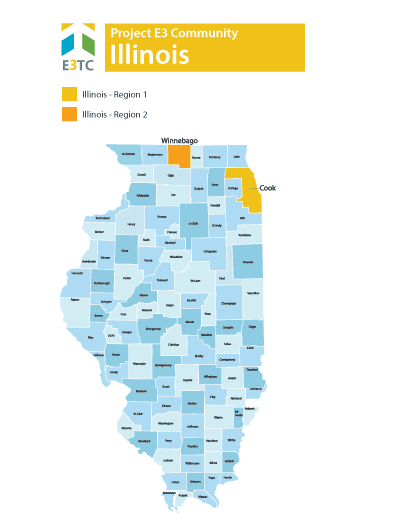Illinois was chosen as a targeted community through the Vocational Rehabilitation Technical Assistance Center: Targeted Communities (VR-TAC-TC) or Project E3. Project E3 partnered with State VR Agencies and local community partners to improve outreach and employment-related services to underserved people with disabilities in these communities.

Illinois is known as the “Prairie State”, as it was once covered with prairie grasses. Today, there is a combination of small industrial cities, agriculture, and natural resources like coal, timber, and petroleum. Illinois is also a major transportation hub connecting global ports from the Great Lakes and the Mississippi River.
Illinois is primarily divided into three sections. Northern Illinois is dominated by the city of Chicago and its suburbs. This area is heavily populated and industrialized. Central Illinois is mainly prairie and made up of small towns and medium cities. Agriculture and manufacturing centers are prominent. Southern Illinois has a warmer winter climate good for different varieties of crops, more rugged terrain, and small oil and coal mining operations.
The cultural diversity of Illinois can influence career participation and disability identification due to cultural backgrounds, language barriers, education levels, and lack of exposure to different types of work.
Targeted Communities
The state-federal vocational rehabilitation system in Illinois faced many challenges as it strove to serve people with significant disabilities and promote competitive integrated employment. Project E3 provided intensive technical assistance to two regions in the northeastern and northern parts of the state:

Key Information:
Justice System
who have significantly been a part of the justice system have a significant disability.
who were formally incarcerated are receiving vocational rehabilitation services.
Foster Care
who have aged out of foster care have a severe disability.
who aged out of foster care is receiving vocational rehabilitation services.
Unemployment
National rate = 4.1%
Poverty Rate
National rate = 14.3%
Targeted Populations
Within the targeted communities, Project E3 focused on improving vocational rehabilitation service outcomes for these populations:
These populations were characterized as:
Primary Challenges for Targeted Populations
The combination of the challenges above and other factors created significant barriers for persons with disabilities living in Illinois, including:
Key Strategies to Address Barriers
Following are some of the key strategies developed and implemented to address the targeted populations' challenges and barriers to employment.
Community-Based Participatory Research (CBPR): To understand a community’s issues and concerns, one needs data and information both supplied by common data sources and interpreted by the community to better understand their issues and possible solutions to those issues. CBPR’s methodology is predicated on deep and extensive community involvement in the identification of issues and concerns and in the resolution of those issues and concerns.
Community Outreach and Orientation: The goal of community outreach and orientation is increased referrals for vocational rehabilitation services from community-based organizations and applications from people with disabilities. To achieve this goal, developing relationships within local communities is essential. Community outreach and building knowledge about the hiring people with disabilities is key.
Evidence-Based Practice Training: The Illinois Department of Rehabilitation Services has contracted with the University of Illinois to continue E3 related programming for the next 5 years. The focus of the training will be VR counselors. The goal is to develop a series of training and other capacity building activities for the state that will be implemented over multiple years.
The Illinois Brief Screener: This evidence-based screener has been developed and will be provide to direct care staff at Community Based Organizations as a useful tool to assess if a person may be a good fit for VR services in Illinois.
Customized Employment: The project developed and wrote a Customized Employment Manual that will be distributed within Vocational Rehabilitation. This tool will become a vital resource in the training of Community-Based Organizations, Vocational Rehabilitation Professionals, and other stakeholders in customized employment.
- Customized Employment Handbook for Serving Youth with Disabilities in Foster Care: A Handbook for Rehabilitation Counselors and Community Rehabilitation Providers
- Customized Employment Handbook for Previously Incarcerated Individuals with Disabilities: A Handbook for Rehabilitation Counselors and Community Rehabilitation Providers
Illinois Overview PowerPoint Presentation
Project Outcomes
Project E3 provided Illinois’ state Vocational Rehabilitation agencies and their partners with the skills and competencies needed to effectively and efficiently address barriers to competitive integrated employment and community integration encountered by persons with disabilities in these regions.
Our specific goals for this project were to:
We will leverage promising practices, knowledge, and experience gained from this project to expand employment opportunities for individuals with disabilities from underserved and economically disadvantaged populations throughout Illinois and across the United States.
Tools and Resources
- Customized Employment Handbook for Serving Youth with Disabilities in Foster Care: A Handbook for Rehabilitation Counselors and Community Rehabilitation Providers
- Customized Employment Handbook for Previously Incarcerated Individuals with Disabilities: A Handbook for Rehabilitation Counselors and Community Rehabilitation Providers
More Information
For further information about these community activities contact:

Dr. David Strauser, Ph.D., CRC
Professor, Department of Kinesiology and Community Health in Rehabilitation Psychology
strauser@illinois.edu


